#silver skysail
Text

Hey there, patrolling guardsman of this derelict outpost- Those rumors about a restless spirit haunting this moon are just rumors haha right?
Uh...
Right...?
#Archer art#oc tag#silver skysail#spoiler alert the Terror of the Wastes is very real. just stay out of the way and don't be too annoying and you should be fine. probably#even after those initial Events(TM) Sid will still get an occasional dream of wandering the area around the outpost#wakes up suspiciously un-rested like he did indeed go hiking#goes back there after a while and wouldn't'ya know it the rumors of a pale-clad ashen specter are still going strong#eyes like desperate lamps reaching through the wind and snow before blending back into the snowdrifts and out of sight#yes there are some that have gotten a good look at 'the specter' yes they are aware that he looks identical. no one wants to bring it up
9 notes
·
View notes
Text
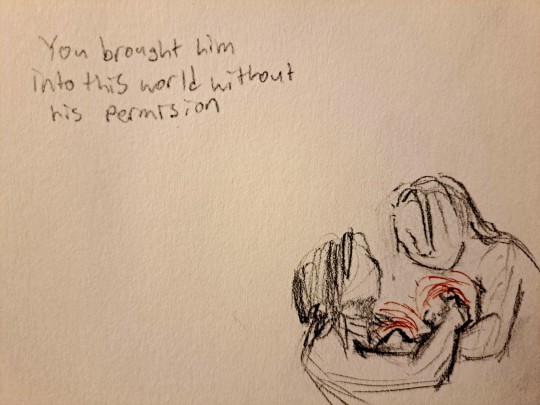
[Steals a quote from a show i like and runs]
#having Another Version Of Yourself? what a concept!!#Severance#Skysail#i need an oc tag#sid sibyl#silver skysail#i have way too many ideas to sketch out#we'll see if i come back later to paint this
10 notes
·
View notes
Text
Cannon Character Descriptions
Here’s a big master post of cannon character physical descriptions, for all your related needs. Let me know if there’s anything I missed/should add!
Ana
"She had warm bronze skin and wide golden-brown eyes, full lips, and a heart-shaped face. Her hair was as dark as space itself, but it always curled into tangles. She wore it atop her head in a long braid and shaved the sides. She was moderately tall, solidly built for a life of evading death at every turn, and wore hand-me-down coats like the red one she wore now and darned trousers that never fit right. She looked like a girl from any part of the Iron Kingdom—and nowhere all at once.” (HoI, I: Iron Theif, Ana)
“Tattered burgundy coat, a Metroid at her hip, long black hair in a renegade braid, and looking like she hadn’t bathed in a week—the girl must’ve been an outlaw.” (HoI, I: Iron Theif, Robb)
When Ana arrives at the palace and is shown to her new quarters she has a little break down in the bathroom -- and who hasn’t had one of those? -- and shaves her hair off. In SoS, 6-months have passed since the coronation day and her hair is describe merely as “short”.
Di
As D09: “His hood was pulled low to disguise the slats and plates that made up his face, without a nose or ears or eyebrows. He was more dented than other Metals, having fallen through mine shafts on Cerces and been shot at by mercenaries on Iliad. She felt bad for a particular ding on his forehead, but she had apologized a thousand times for accidentally running him over with a skysailer.” (HoI, I: Iron Theif, Ana)
As Di/Dimitri: “Redheaded and dark-eyed, a strong jaw, and broad shoulders that filled a slightly-too-small lavender evening coat. He smiled at her—lopsided, imperfect. He looked familiar, but she couldn’t place from where. ... So close, the individual strands of his hair looked woven with sunlight, his skin pale—but not like Jax’s, more like a boy who had never seen the sun." (HoI, IV: Iron Will, Ana)
“So she memorized how the light from the windows slanted across the sharp edges of his face, the way he leaned toward her like a shield, how there were a thousand stars in his eyes, which sometimes made them shine as silver as moonlight—as they did now.” (HoI, IV: Iron Will, Ana)
Di received a cut on his cheek during Coronation Day that is held with silver stitches during SoS to prevent the cut from revealing the metal underneath. He also has a little breakdown -- as one does -- in which he busts up the skin on his knuckles, which he hides then with gloves.
Throughout SoS, Di’s hair is often remarked very specifically as “Blood red”, and he wears quite a bit of black.
Jax
"A Solani. The one from the skysailer. He must’ve been close to Robb’s age, but his silver hair made him look old—ancient—and his skin shimmered as if starlight hid just beneath. He wore a ruffly purple evening coat, golden filigree decorating the collar to match the lining, and buttons so polished they gleamed. Underneath that insufferably garish jacket was a silk shirt, stained with what Robb figured was his blood. A pair of goggles sat around his neck.” (HoI, II: Iron Ships, Robb)
Wears purple often; after the event with Koren Vey, his skin literally glows. “”It’s a long story, but yes, I’m a glowlight. It makes reading in the dark riveting.” (SoS, III: Starless, Jax) Also in SoS, Jax has to chop his own hair off during the final fight, resulting in him sporting a shoulder-length cut during Erik’s funeral; according to Robb, he looks no less dashing for it.
Robb
“He looked the most like their father, broad shouldered and stocky, with hair that curled like the lies that fell from his tongue.” (HoI, I: Iron Theif, Robb)
Like his mother and brother, Robb also has olive skin and signature Valerio-blue eyes, often compared to the Erosian sky. In HoI, Jax threatened to make a short joke (mind you, Jax is tall); in SoS, Robb notes that he was always shorter than his brother, but a recent growth spurt had now made them eye-to-eye.
In the conclusion of HoI, Di -- then HIVEd -- made his tracking chip go haywire and an impromptu amputation was needed, cutting his right arm off between his elbow and his shoulder. Robb got a cybernetic prosthetic about a month before the events of SoS.
Elara
“She was around Ana’s age -- eighteen, maybe -- with shoulder length silver hair that partially shadowed her sharp face, and wide violet eyes rimmed with kohl. Her lips were painted black to match the rest of her wardrobe. She was short and curvy, with wide hips and thick legs that tapered into knee-high gravity boots. She was a Solani like Jax, but her skin was darker, reminding Ana of the cold deserts on Cerces. There was a wire that looped from her right ear down into her collar and disappeared. A hearing apparatus.” (SoS, I: Starship, Ana)
Xu
"Then -- like twin stars igniting -- moonlight-colored eyes flickered to life on a face made of metal slats, forming angular cheekbones and mouth and chin. There was a horrible, deep scrape across its temple that had been soldered closed. A Metal.” (SoS, I: Starship, Ana)
Malifare
“She walked with the grace of a dancer, floating without a sound. The pins in her flaxen hair matched her black dress. Floor-length, high collar, the insignia of the crown on her sleeve.” (HoI, I: Iron Theif, Di)
“Flaxen hair, narrow face, wearing the deep purple of a royal handmaiden." (HoI, IV: Iron Will, Di)
Siege
“The captain’s black hair framed her brown face in wild, electrifying curls, glowing with interwoven fiber optics, simmering orange like a stoked fire— Oh, Ana could tell by the color that she was mad.” (HoI, II: Iron Ships, Ana)
Siege has green eyes. When she isn’t mad her hair is typically a golden yellow, though it grows dull when she’s drained or injured, and can be blue though it happened very rarely. As a teenager -- in a very hazy recollection by Di -- she’s described as someone who never smiles.
Talle
“Talle—short and thin, with black hair in a pixie cut and hands so steady she could slit a throat clean while navigating the skyways of Nevaeh...” (HoI, II: Iron Ships, Ana)
In Jax’s flashback in Soul of Stars, Talle is described as tall with long black hair, but I’ll just assume that Talle is simply tall compared to an 8 or 9 year-old Jax. (SoS, II: Starless, Jax)
Also, her voice is often noted as sweet.
Lenda
““Seriously?” Lenda groaned, brushing back her floppy dishwater-blond hair. She was solid, with narrow brown eyes and tawny skin with rosy undertones. She displayed the scars on her arms like trophies—battles won in the fighting arenas of Iliad. Lenda was twenty and unafraid of everything— Except, maybe for Palavar.” (HoI, II: Iron Ships, Ana)
Riggs
"Riggs, fiddling with a ball bearing in his mechanical leg, grumbled a reply and heaved it off the table, setting it on the bench beside him. He’d lost his right leg to the Plague twenty years ago—cut it off himself right above the knee. He lost his family to the disease on Eros, and kept a photo of his daughter in a silver locket around his neck. Sometimes at night, Ana heard him talking to her in his dreams." (HoI, II: Iron Ships, Ana)
Wick
““No one [likes Palavar],” rumbled Wick, who had a habit of being quiet. He listened, and that made him a talented communications specialist. He absorbed languages like a sponge, so many that Ana could only hope to wrap her tongue around a quarter of them. He was Cercian by birth, the markings under his eyes so faded Ana couldn’t tell which clan he hailed from, and he never told, having left that life years ago. His skIn was a shade darker than Siege’s, with a warm hue to it—like the dawn.” (HoI, II: Iron Ships, Ana)
Barger
““Eh, don’t bother me. Three jacks,” said Barger, a stout man in his mid-twenties with a ginger mustache. His fingers were always grease stained, nails ripped short, the signs of a tireless weapons mechanic.” (HoI, II: Iron Ships, Ana)
Cynthia Valerio
“Lady Valerio looked wicked, from her bloodred lipstick to her bloodred dress, as she gave a gracious bow.” (HoI, I: Iron Theif, Ana)
“Tall and thin, with olive skin and graying brown hair swept into a bun, cheekbones so sharp they could cut ice. She wore a finely detailed coat and trousers, a Valerio crest pinned above her heart. She appraised the small crew with shrewd blue eyes—he knew that color. He knew it achingly well. The color of Erosian skies.” (HoI, III: Iron Blood, Jax)
Mercer Valerio
Robb is his spitting image, except that Mercer wore a thick beard.
Erik Valerio
“At nineteen, Erik Valerio was dashing, popular, and conniving in a way that granted him whatever he wanted. He looked like their mother—tall and olive skinned, a sharp face, with straight dark hair and a smile that made you want to trust him.” (HoI, I: Iron Theif, Robb)
“His brother stood blocking the doorway in a deep brown leather jacket with mink fur at the collar and dark trousers. His boots were well polished and decorated with the Valerio insignia—a snake eating its own tail. He filled the doorway just like he had in Robb’s nightmares, his hair short, the sides shaved with celestial designs, and he narrowed his eyes like their mother always did—disapproving, but not surprised, as if nothing Robb would ever do would be worthy of approval.” (SoS, IV: Star Crossed, Robb)
Erik and Cynthia often match, both wearing red at the celebration for Erik becoming the heir, both wearing black at the pre-coronation ball, and both -- this time including Robb -- wearing white at the coronation itself.
Nicholi
“The Emperor, clad in royal purple, had a hand on his wife’s shoulder. He looked like all the pictures she’d seen in the newsfeeds. Golden-brown eyes and rich brown skin, like the Grand Duchess, a full beard over a strong face.” (HoI, III: Iron Blood, Ana)
Selena
“Beside him, his wife, the Empress, smiled out of the portrait, brown curly hair and Valerio-blue eyes.” (HoI, III: Iron Blood, Ana)
Rhys, Wylan, and Tobias Armorov
Ana’s three older brothers are described as having dark curly hair, and the youngest, Tobias, has Valerio-blue eyes. They’re described further in short snippets Ana recalls in the palace, chasing the ghosts of their voices:
“Rhys— He let her taste the sweets from the kitchen. The scent of cinnamon. Warm brown eyes, a melting smile. He used to kiss her bruises when her middle brother, Wylan—a cocky smile and a mess of black curls—knocked her down when they pretended to be outlaws. All the horseplaying would scare her youngest brother—Tobias. Valerio blue eyes and a small smile and a love of violins and sweet candies and stories.” (HoI, IV: Iron Will, Ana)
Lord Rasovant
“An older man, graying beard braided down his chest, appeared at the far end of the hallway. Dark eyes and deep wrinkles and ghostly-pale skin. The clank of decorative medals on his breast accompanied his footsteps. He was dressed in a simple royal-purple evening coat with uneven tails, gilded buttons and filigree across the collar and sleeves.” (HoI, I: Iron Theif, Di)
The Grand Duchess
“Ana drank the woman in, from the delicate wrinkles across her face to her silvery-white hair pulled back into a simple bun, making her cheekbones look sharp enough to cut. Her skin was the color of soft earth and speckled with age, her hands bony knobs. She looked old, but in a terrifying and timeless way, the way mountains looked old but immovable.” (HoI, I: Iron Theif, Ana)
She also has “...stone-cut green eyes...” (HoI, IV: Iron Will, Robb), similar in description to Siege’s
Wynn Wysteria
Wynn has a freckled face and long, curly strawberry-red hair. (HoI, IV: Iron Will, Ana)
Viera
“She was tall, with white-blond hair and arrowhead-shaped markings under her eyes—heritage markings for certain Cercian clans.” (HoI, I: Iron Theif, Di)
Messiers
“A patrol of six Messiers appeared in the doorway. They were sharp, metallic. Made of planes and slats she knew well, because they looked like D09. Like Metals. Because once, they had been. Now HIVE’d, the Messiers’ blue eyes blazed like virtue incarnate. They moved in unison, their blue-and-black uniforms pristine, shined boots making solid thumps on the masonry floor as they marched into the shrine.” (HoI, I: Iron Theif, Ana)
Mokuba
“A tall, burly gentleman in a stained long coat and trousers, the seams frayed and boots greasy.” (HoI, I: Iron Theif, Ana)
Redbeard
“He had been an imposing man, as thick as two men. He had a braided red beard that reached halfway down the front of his barrel chest, and it glowed with optics the way Siege’s did, although Ana much preferred the way they looped into her curls.” (SoS, III: Starlit, Ana)
Cullen
Ana spun around to the owner of the voice, a tall androgynous person with long black hair that reached well below their waist, and warm brown skin, decked in gold jewelry and a coat the color of a nebula. They grinned at her, and the neon implants in their cheeks glowed a brilliant teal. (SoS, IV: Star Crossed, Ana)
4 notes
·
View notes
Text
TaskMaker: Won! (with Summary and Rating)
Can my reward be a haircut?
TaskMaker
United States
Storm Impact (developer); XOR (publisher)
Released 1989 for the Macintosh
Remade and re-released as shareware in 1993
Date Started: 15 May 2020
Date Ended: 25 May 2020
Total Hours: 13
Difficulty: Moderate-Hard (3.5/5)
Final Rating: (to come later)
Ranking at time of posting: (to come later)
Summary:
TaskMaker is perhaps the perfect Macintosh game. A challenging game with an easy interface, TaskMaker takes the player on a top-down quest to complete 10 tasks for the titular lord, each one progressively more ominous and evil, until at the end the player has a fateful choice. Gameplay is like a combination of early Ultima and a roguelike, with challenging combats made easier through a vast inventory selection. An unusual set of attributes governs success and gets stronger when exercised. Many of the dungeons have complex puzzles involving teleporters, switches, and hidden doors.
***************
The best metaphor I can find for my TaskMaker experience is that I just had an excellent lunch. It was tasty, filling, and didn’t do anything wrong except lack the gravitas of dinner. It won’t unseat Ultima on the GIMLET–no game that lasts only two entries is going to do that, any more than a great lunch place is going to show up on a city’s “best restaurants” list. But for the meal that it offered, it offered it perfectly. I need a way to distinguish such games beyond the raw quantitative score of the GIMLET.
I wonder if a truly epic, dinner-worthy RPG has been created for the Mac. It’s not like the hardware and software wouldn’t support it, and of course it receives ports of such games. But something about the operating system seems to encourage games (or, indeed, perhaps all applications) that are the equivalent of dragging files to the trash can: tidy, cutesy, intuitive, and yet a bit groan-worthy to someone who grew up typing DEL FILE.TXT and still finds it easier to do so. TaskMaker avoids the worst of other Mac games in this regard–its main character is not, for instance, a smiley face–and it admirably backs up almost all mouse commands with keyboard controls, but it still has that sense of being an “app” rather than a program.
Making cute drawings out of the dungeon wall pattern is something that a Mac game would do.
Still, the focus belongs on the positives. The titular TaskMaker had ten tasks for me:
Retrieve a package from Skysail Village.
Retrieve a chessboard from within the castle.
Invade the silver mines, kill the usurpers, and bring back a golden chalice.
Dig in the sands of Porta to find a magic item.
Remove his belongings from the Quagmire Estates.
Steal the coat of arms from the Enitsirhc Family, which “resists [his] reforms.”
Slay and bring the head of the leader of a rebel faction in Dripstone.
Raid the crypts at Pentamerous and bring back the body of the previous king.
Bring back the crown of the land from Vidair’s Tower.
Murder the prisoner in the TaskMaker’s island prison.
The steps needed to accomplish these tasks are designed exactly as they should be in a game of this nature. Too many developers, in such a situation, would mistakenly try to create “symmetry” among the tasks by giving them all a similar structure and length, or even worse make them escalate in complexity. But TaskMaker does it right. Some of the tasks are easy, some are hard. Some are long, some are short. To the extent that any are challenging, the challenge is a bit different for each. The variety keeps things interesting and prevents the player from learning to dread the next task.
Digging holes in the desert was boring but easy.
Even better, while the task order is linear, the game world is not. The player could perform all of the tasks before speaking to the TaskMaker once, then stand in front of him and turn them in all in a row. Nothing is gated. If he knows what he’s doing, or just has a bit of daring, he can plunder some of the best equipment early in the game. It would be fun to do a speed run of TaskMaker just to see how quickly you could complete it.
Mapping out a teleport puzzle in one of the last dungeons.
I particularly love that the player didn’t put up artificial barriers to two slightly game-breaking options: The “Teleport” spell, which moves you to a random place in the current map, and various items that let you walk through walls (e.g., Ethereal Potion, Passwall Scroll). Most games would offer these options but keep you from using them when they really counted. Not this one. I got lucky with a “Teleport” spell on Task 9 and bypassed most of what was probably the game’s toughest dungeon. That in some ways, it’s too bad that you can do this is outweighed by how awesome it is that you can do this.
The easiest tasks were #2–the chessboard was just down the hall, though guarded by some tough early-game foes–and #10. The toughest were the ones that had long, large dungeons: #3, #6, #8, and #9. The game specialized in Dungeon Master-style puzzles like switches, teleporters (visible and invisible), energy barriers, and illusory walls. Vidair’s Tower consisted of about 50 small areas interconnected by such devices. They ultimately frustrated me, even though I could have taken the time to map them, and on a different night may have had a great time doing just that. On the particular night I was playing, my impatience led me to try “Teleport” and I was tickled to see it rewarded.
A choice of three staircases and a teleporter. Instead of mapping all these paths, I rolled the dice and got lucky.
The combat difficulty I reported in the first entry got easier as the game progressed and I got better equipment. I still probably over-relied on the “Instant Vacations” that my deaths unintentionally replicated, but those deaths became rarer as the game went on and, in particular, as I learned how to effectively use the spells. This is another area that the game does quite well. There are ten spells given to you at the outset, and all are useful. Even if you don’t use “Teleport” to bypass dungeon puzzles, you can use it to get out of combat. Even a melee player should use “Attack” frequently because it applies your physical attack to all adjacent foes. “Haste” lets you escape monsters (as well as fight them more efficiently). Even better, NPCs give you additional spells throughout the game, called by casting the “Invoke” spell and then typing their names. HOME is a particularly useful invocation that warps you out of wherever you are and back at the starting location. As I speculated last time, casting spells is what exercises “Intellect” and “Spirit” (and to some extent, “Health”) and causes those maximum bars to increase.
TaskMaker also gives you a lot of inventory resources to take the edge off combats, first in the form of increasingly good stuff to wear and wield, but also in a fun variety of usable items like scrolls, wands, and potions. It is in this area that the game starts to feel a bit like a roguelike, although without the interaction between objects that characterizes that sub-genre.
It probably doesn’t surprise anyone to learn that the TaskMaker is actually evil–he does call himself “The TaskMaker,” after all. From the game’s earliest moments, his over-reactions if you return to him without completing the task show at least a lack of kingly composure, if not outright malevolence.
Lord British never gave me this kind of quest.
You start to get real confirmation of his villainy during your invasion of the castle of the Royal House of Enitsirhc (the developer must have known someone named “Christine”; there’s also a Scroll of Christine in the game). NPCs say things like, “No one must serve the TaskMaker” and “Please help us. Kill the TaskMaker.” In Dripstone, you get the sense that the rebels are more like freedom fighters than terrorists. As a reward for Task 8, the TaskMaker says “may this keep you ever faithful” and then gives you “DRUGS!”
The TaskMaker’s instructions on the final task are also a bit of a clue.
Unfortunately, you can’t do anything about it until the final task. If you try to turn on the TaskMaker and slay him during any of the previous game, he just laughs at you. You don’t really get any choice until the final task, when you visit the incarcerated prisoner, apparently another rebel leader. “He wants absolute power of the kingdom,” the man says, clearly speaking about the TaskMaker.
If at this point you choose to kill the man, he says “you just killed a good guy” as he dies. From then on, every NPC in every town is hostile to you. When you return to the TaskMaker, he mocks you for following all his orders and then apparently has you killed. The game isn’t 100% clear.
Also, he’s either undead or really good at illusions.
If instead you leave the prisoner alive, the TaskMaker attacks you upon return, also bringing his guards into combat. I didn’t find the battle very hard. I don’t think I had to even dip into one of my “Instant Vacations” or healing potions.
Fighting the TaskMaker in the final battle.
When he dies, you get the message at the top of this entry, but even better, you get a new special menu called “Master,” which gives you godlike powers over the game world. You can conjure any object, NPC, or monster; change the tiles to any type of floor, furniture, or wall; and toggle time stop, x-ray vision, and ethereal movement. Among other things, this gives you the ability to fully investigate dungeons you may have only partly mapped. It turns out there was a lot to find in the TaskMaker’s very own castle. What a fun reward.
Using my new powers to block my throne room with fire.
In a GIMLET, the game earns:
4 points for the game world. The backstory doesn’t break any new ground, and there isn’t much lore, but I like the way that your actions have permanent consequences (which you can reset!) and the way that the “Info” command gives you a little history of each new location. I just wish the TaskMaker hadn’t been called such in-game and the game had taken his story and yours a little more seriously and thus put a real dagger blade on the twist ending.
4 points for character creation and development. The creation process (specifying qualitative attributes) is creative, and I like that your development is based partly on how you act. I like that it’s possible to gravitate towards a warrior or mage “build” based on what skills you favor. I do wish that the game offered more options than just warrior or mage, and that it made better use of its own alignment system.
3 points for NPC interaction. Unfortunately, I think NPCs were a lost opportunity for this game. Instead of using them to introduce game lore, the developer just gave them each one or two lines (depending on whether they have anything different to say after you bribe them). None of them are really necessary, and only a tiny percentage are even helpful.
Even when bribed, the rebel leader tells me nothing I don’t already know.
3 points for encounters and foes. Foes are just names and how hard they hit. There are no special attacks or defenses, and a lot of the time, I didn’t even pay attention to the names. The non-combat encounters, in the form of puzzles, were more interesting.
5 points for magic and combat. It seems like you just stand in front of enemies and exchange blows, but as I mentioned, the game’s approaches to magic and inventory give you a lot more to do in combat than just keep hitting “fight.” I like the magic system with its “extra” spells, many of which I didn’t discover.
An NPC gives me a new spell keyword.
7 points for equipment. The game is generous with useful inventory, inventory slots, and backpack space. It lacks the descriptions, crafting, and interactions among items that would be necessary for a higher score.
5 points for economy. It’s useful until about halfway through the game, when you amass so much money the store no longer sells anything you need. The ATMs are a fun touch, though one of many things that make it hard to take the world seriously.
4 points for a main quest, in manageable stages, with a couple alternate endings and side-areas.
The “evil end” of the game.
3 points for graphics, sound, and interface. It gets most for the interface. I found the graphics a bit too detailed for what the resolution was actually able to deliver, and the sound with its recorded voices contributes to that “cutesy” Mac quality I talked about. The first two times I heard “what is it?” when I went to identify something made me chuckle. Then I turned the sound off.
7 points for gameplay. It’s as nonlinear as it can be for a game that presents tasks in a fixed order. It lasts a perfect amount of time for its scope and offers a near-perfect challenge. It’s also extremely replayable–I know I missed a ton of content in my first pass, and this is just the sort of game that would make speedrunning fun.
That gives us a final score of 45, significantly higher than the highest score I’d previously given to a native Mac RPG (Shadow Keep’s 36), high enough to put it in the top 15% of games played so far.
TaskMaker was written by David Cook, whose company, Storm Impact, was based in Illinois. David did most of the coding for the company’s games, while Tom Zehner did most of the large-scale illustrations, including the TaskMaker title screen and TaskMaker portrait. Dan Schwimmer and Dave Friedman helped with playtesting and map design. The team had met in high school and college and were in their first years at college when they founded the company. While TaskMaker sold reasonably well, the company’s most successful game was MacSki (1990).
For years, the original version of the game was lost, but reader LanHawk wrote directly to David Cook and asked him for it, and David obliged. I later corresponded with David by e-mail. He said that TaskMaker began as a Dungeons and Dragons campaign. (This is probably the source of the incorrect statement, found on several web pages, that TaskMaker was originally a board game.) In porting it to the Mac, Tom says he was influenced by Ultima and The Legend of Zelda. But he intended to create a persistent world in which multiple characters could operate even if they couldn’t exactly play together. Future characters would have to contend with the detritus of slain ones. This separation of character state and world state created the unintended item replication bug.
The color in the remake makes it easier to tell what the graphics are supposed to be depicting.
Version 2 of TaskMaker was released in 1993. This is the one that more players are familiar with. Having experienced a couple hours of it, I don’t believe it’s different enough from version 1 to warrant a new game number and set of entries. The most significant changes that I can see are:
It’s in full color (but otherwise uses most of the same graphics).
It comes with a tutorial to get you used to the conventions.
Some keyboard commands have been changed.
Some spell names have been changed and the “Teleport” spell is gone.
There’s no character creation process. Everyone starts with equal values in all attributes.
The score only increases; it doesn’t decrease over time.
The remake comes with a tutorial with magic mouths. Somehow this makes it feel even more like a Mac game.
The save states for the world and character are unified, so the item duplication glitch is gone. You can no longer “reset” a map or the game world.
There are a few additional sound effects.
The runic language is gone; wall messages are now in English.
Combat is quite a bit easier.
Food depletes at a much slower rate.
Task #4 no longer has you digging randomly in the desert but rather sends you to a new “Arbalest Catacombs” map.
Visiting in the TaskMaker in the remake.
The increases are mostly an improvement, and I suspect that if I’d played the 1993 version from the outset, the GIMLET would have come in at maybe a 47 or 48.
Storm Impact dissolved in the late 1990s, but David Cook still sells TaskMaker and the company’s other titles on his web page. I can look forward to 1997’s Tomb of the TaskMaker. For now, I think I’ve had enough of a break from The Black Gate to give it another shot.
source http://reposts.ciathyza.com/taskmaker-won-with-summary-and-rating/
0 notes
Text

Solo Trek
#Archer art#oc tag#silver skysail#sid sibyl#he's used to traveling on his own- but even the illusion of company helps#Silver in this case would not be affected by the wind even a little bit but doesn't want Sid to feel left out#also i wanted an excuse to draw parts of their outfits being used as hoods
4 notes
·
View notes
Text
Give your OC an edgy shadow clone! It's fun and it's free
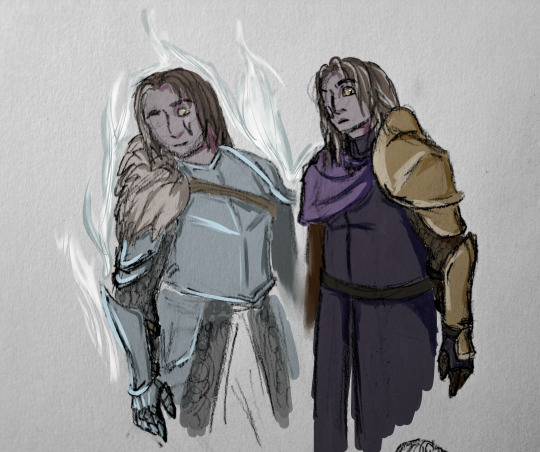
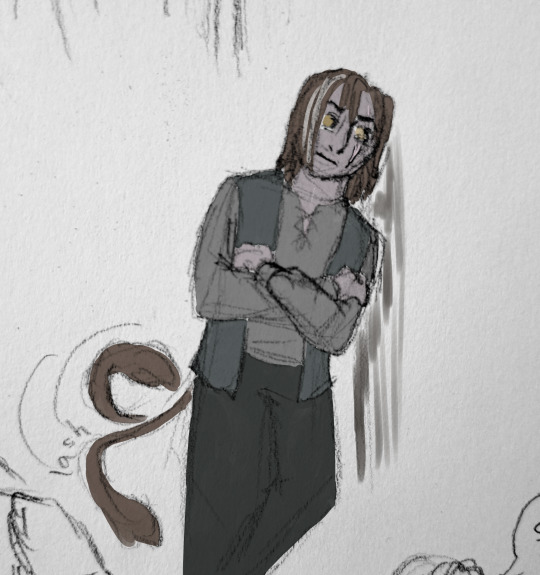

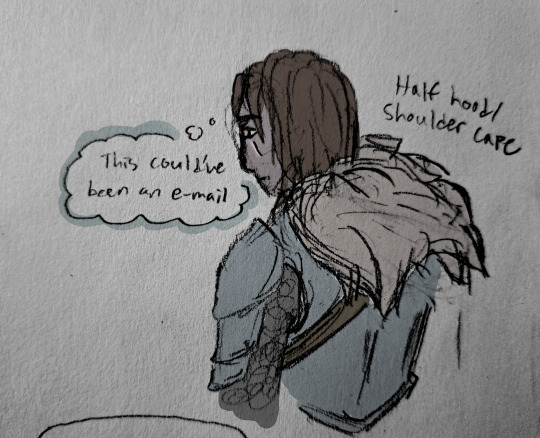
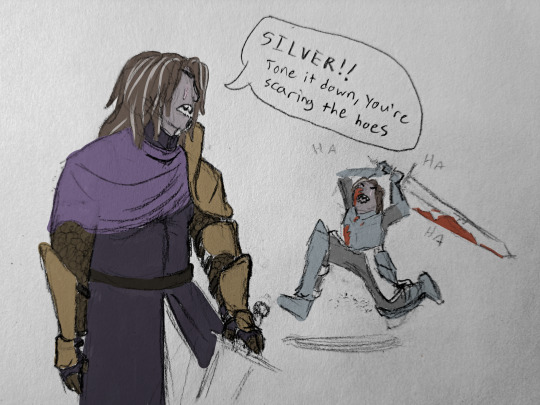
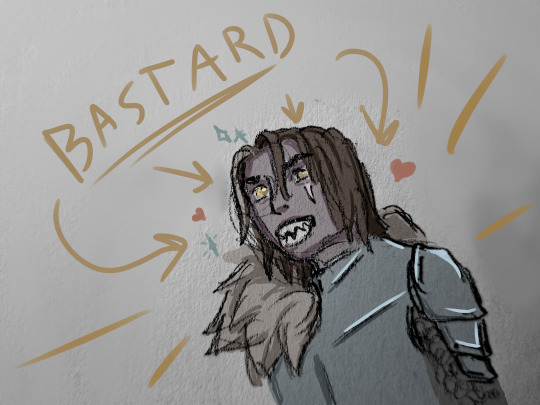
#Archer art#oc tag#sid sibyl#silver skysail#I told myself 'silver' was a placeholder name but I worry it's actually growing on me#not so much evil just. has less inhibition than mr. sibyl. which can be very helpful at times!#don't worry about their origin for now I'll get around to it eventually#goes by they/them bc they're based on a slightly younger version of Sid that hasn't quite fully figured themself out yet#also why they're smaller than he is#can you tell I liked Dr. Jekyll & Mr. Hyde
9 notes
·
View notes
Text
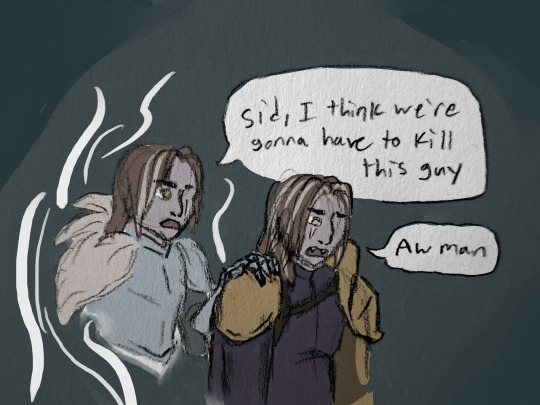
didn't realize this was popular on twitter so here's the meme on its own with my oc(s)
#Archer art#oc tag#sid sibyl#silver skysail#written as oc(s) because an argument could be made for them being the same person
5 notes
·
View notes
Text
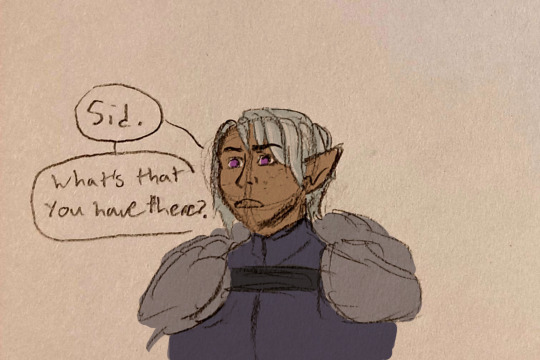
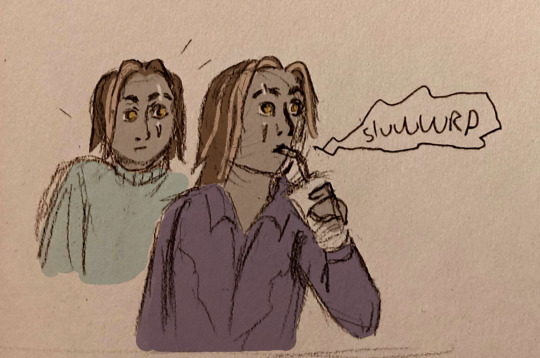
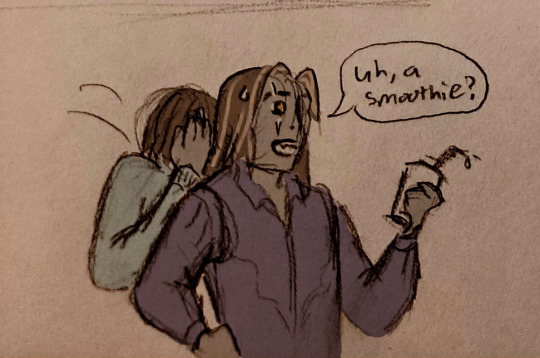


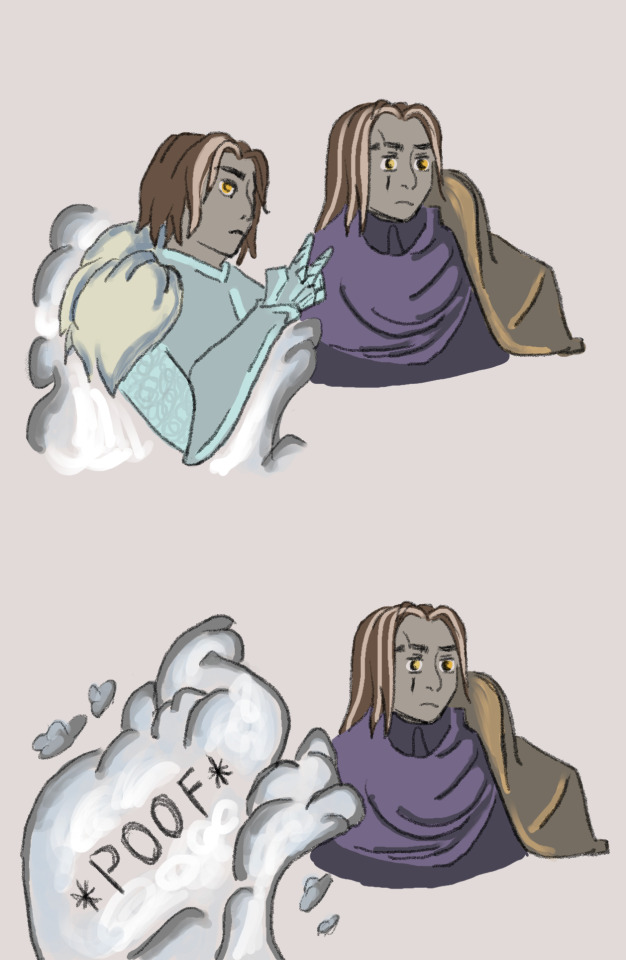

another sketch dump, click on the pictures i think the quality got nuked
#Archer art#oc tag#Sid Sibyl#Silver Skysail#silver at any given moment: 'cool. anyways-' [fucking evaporates]
4 notes
·
View notes
Text
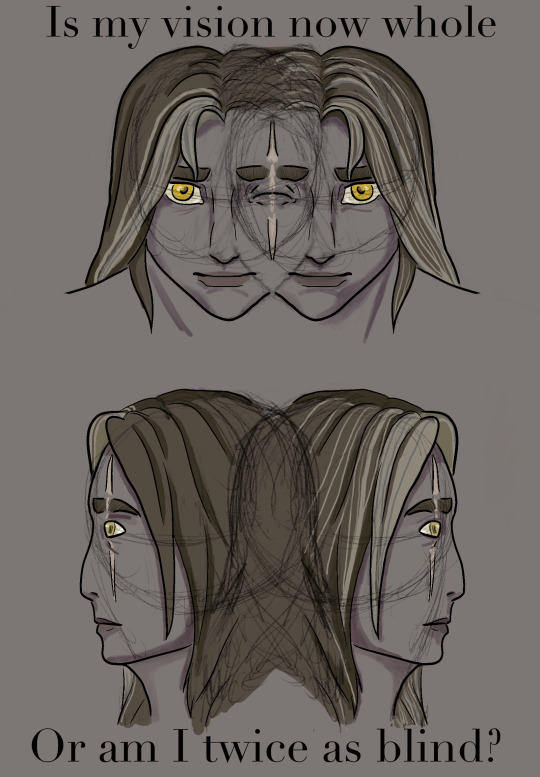
Not a copy, but a mirror-
#i need an oc tag#sid sibyl#silver skysail#trying some new stuff with my new tablet :]#also did some lineart. for once#it was actually very nice i'm gonna have to make a habit of it
4 notes
·
View notes
Text
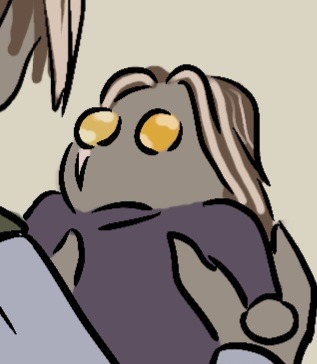
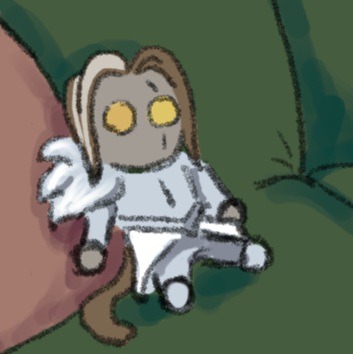

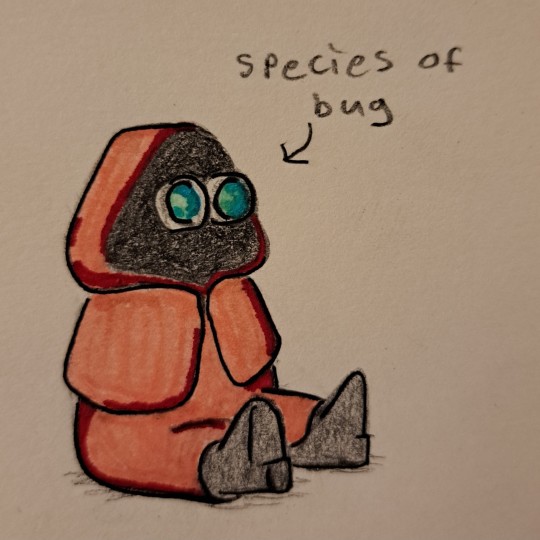

actually y'know what, I'll start keeping all my doll/bug oc doodles in one place
#Archer art#oc tag#sid sibyl#silver skysail#bosun phayne#telaruus phayne#balthazar#surprising that not only have i NOT drawn Balthazar as a wet seal yet. but he got beat out by Sid Sibyl of all people
2 notes
·
View notes
Text
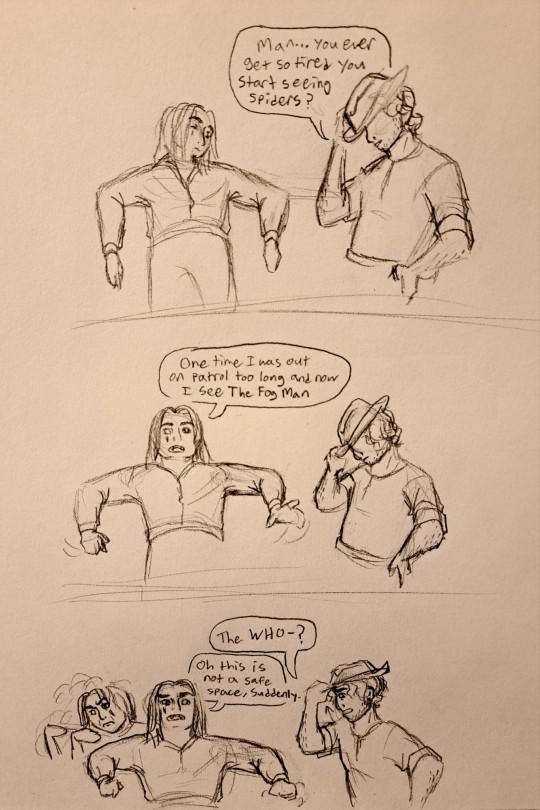
Yeah he doesn't bring up Silver too often-
#Archer art#oc tag#sid sibyl#deuces#silver skysail#my two greatest trials- cowboy hats and foreshortening. but I will not be deterred
2 notes
·
View notes
Text

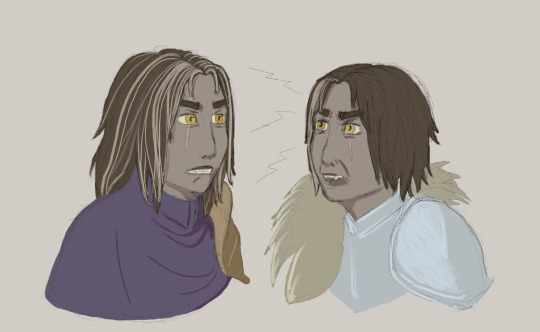
#Archer art#oc tag#silver skysail#sid sibyl#this is literally the dynamic#who's making the decisions and who has to live with them? the answer is Yes. both of them all the time they are very tired#'i'll try and compromise cuz it's not like there's any other choice but goddamn do you/I/we make it Fucking Difficult'
1 note
·
View note
Text
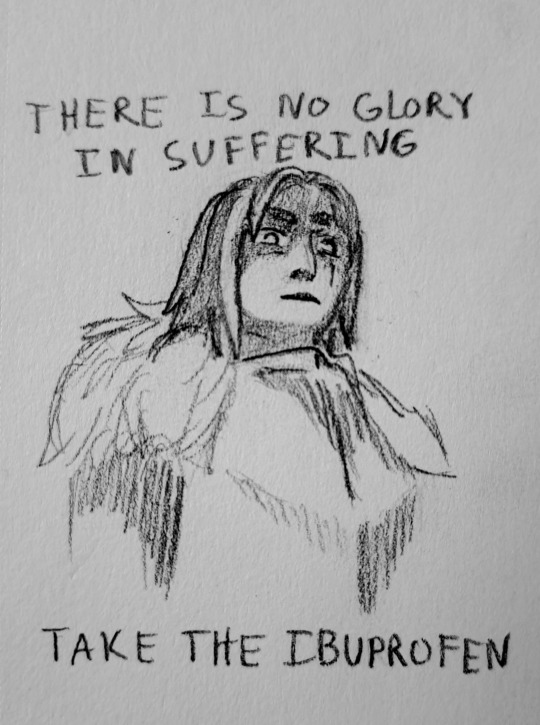
Here's a little Silver sketch to remind you to take care of yourself, or else
#Archer art#oc tag#Silver#skysail#i know i said i was gonna let The Thoughts simmer but also im impatient and want to draw The Bastard
3 notes
·
View notes
Text

Mirror sketch
#Archer art#wip tag#oc tag#Sid Sibyl#Silver#Skysail#Silver get out of the reflection you little scamp-
2 notes
·
View notes
Text

I have decided that for Metaphor Reasons™️ Silver uses a broken greatsword
#Archer art#oc tag#wip tag#Silver#skysail#was worried i was getting a little too subtle with my writing there for a second but i feel much better now#it's not quite long enough for a typical longsword but a bit too long to use as a one-handed sword#such a sword when made intentionally is called a hand-and-half sword. or bastard sword#but since it was originally meant to be a greatsword the blade is narrower which would've helped distribute the weight better#and the grip is long enough that it's a little tricky to use one-handed#at least. i would imagine. i dont imagine my local HEMA chapter would let me break one of their montontes to test this out#anyways dont fuck with Silver unless you're up-to-date on your tetanus shots
1 note
·
View note
Text
Game 367: Taskmaker (1989)
This is a pretty morbid way to organize your “to do” items.
TaskMaker
United States
Storm Impact (developer); XOR (publisher)
Released 1989 for the Macintosh
Remade and re-released as shareware in 1993
Date Started: 15 May 2020
TaskMaker is a slick little game, probably the best I’ve played so far on the Macintosh. It uses the platform’s strengths in graphic detail and sound but offers a fuller RPG experience than most Mac games of the era. While it has that inescapable “cutesy” look of most Mac games, it’s relatively long and hard, and it has enough good, new ideas to break out of the “Ultima clone” status that you might otherwise assign it at first glance.
It’s typical of a Mac game to offer menu options for movement. At least this isn’t the only way to move.
We owe reader LanHawk yet another appreciation pin for tracking this down, in this case writing to the original developer for the files. Because almost everything written about the game is about the 1993 version, being able to cover the original is a nice coup. I’ll have more on the development and the two versions on a subsequent entry; I’ll probably take a run through the 1993 version while I’m covering the game rather than saving it for 1993.
The backstory is relatively short: The land was once at peace, under the direction of a wise king. When the king died, the “governing body split into three confrontational factions.” The main character is an adventurer who remembers the way things used to be. He decides to restore order by becoming Master of the Land, but lacking experience and guidance, he seeks out the TaskMaker, an advisor of the former king.
The TaskMaker introduces himself.
Character creation is a process of selecting a name, then selecting five personal attributes from a list of 20. Your selections calibrate your maximum totals for seven attributes: food, health, spirit, strength, agility, intellect, and stamina. Current totals for these attributes are represented with a bar, and they deplete as you walk around the kingdom and fight. You find various potions and objects to restore lost attributes. Most important are those that restore health, because it depletes fastest in combat, and food, because everything else can be restored with rest.
Creating a character. I imagined this one something of a bard.
The game world is a relatively small 100 x 100, dotted with castles, dungeons, towns, and caves. The TaskMaker lives in a castle to the center-east of the land, and the basic setup is that you go to him, he gives you a quest, you go out into the world to find and complete the quest, and you return to the TaskMaker for a reward and the next quest. Quests take place in towns or dungeons. The game doesn’t make a lot of distinction between dangerous areas and safe ones, as dangerous monsters can appear in towns or castles, including the TaskMaker’s, and NPCs can appear in dungeons.
The game opening has you sailing to the TaskMaker’s shores. Too bad you don’t get to keep the boat.
The equipment system is pretty advanced, offering slots for helmets, armor, cloaks, amulets, belts, gauntlets, bracers, boots, rings on both hands, and an item in each hand–either a weapon and shield, a two-handed weapon, or dual-wielding two weapons (I found the latter to be much better). No matter how much money you make, the shops (which only show you items you can afford) always seem to have a better item available.
Buying items in the shop.
Choosing between two helms.
Monsters are a mix of traditional (goblins, orcs, kobolds) and somewhat original, although most of the original ones are also kind of silly, like happy faces and evil computers. I haven’t met any so far with much in the way of special attacks or defenses. None of them seem capable of magic or attacks at range, for instance. They’re simply differentiated by how many hit points they can whack away in a single combat round.
The “Evil Mac” is a goofy enemy.
Combat is of the early Ultima type, where you hit (F)ight and hit the creature in front of you, although it has a little more complexity with spells and usable items. Combats are quite tough, even well into the game. For the first few hours, I had to repeatedly use what we might call “exit-scumming,” by which I would lead an enemy to the exit of an area, fight as long as possible, retreat to the outer area, rest, and re-enter to continue fighting. This is made possible partly by your one advantage: you can carry a huge amount of equipment–more than 60 items. That’s enough food, potions, or whatever to outlast any enemy. But I occasionally found myself in impossible situations where enemies would appear both outside and inside at the same time.
Battling some goblins on a bridge.
This is where we get into another of the oddities of the game: when you die, you don’t die permanently; you go to Hell. You can escape Hell by fighting your way through demons and solving a maze (if you die in Hell, you just reappear in Hell), but you then have to go find your non-equipped equipment back on the surface. You also lose your gold in the process.
Wandering through Hell’s maze.
This system unfortunately introduces a weird way to cheat. The game tracks the world state independently from the character state. This theoretically allows you to have multiple characters active at once, although I don’t know how this works with the TaskMaker. Thus, if you die and reload instead of escaping from Hell, you’ll still find a pile of equipment where your character last “died.” You could use this to infinitely replicate useful objects like potions or expensive objects that you can sell at the store. I didn’t deliberately cheat this way, but it’s annoying and hard to get out of Hell, and there were times that I reloaded and then picked up some of my old, duplicated items if I happened to come across them. To avoid temptation, I’ve been trying to reload before I die in times when death seems inevitable.
The separation of character from world means that you can also take advantage of commands to reset a particular map or the entire game world, keeping your character as-is. It’s a good option if you want to clear the same dungeon twice, finding double the treasure and experience.
Little piles of stuff mark the location of previous deaths.
The controls are quite good, offering keyboard backups to all of the menu commands. Spells are cast with SHIFT and the first letter of the spell. There’s an “Invoke” spell that lets you type in your own spells that you might find during the game, but it apparently also a way for the developer to introduce cheat codes and interface changes. I’ve been slow to explore spells; the one I’ve used the most is the “Strike” spell which casts a bolt at enemies. I tend to use it on fleeing enemies so I don’t have to chase them.
Sound is also quite well-done. Much of it uses spoken voice recordings. (In fact, one voice they used, a deep bass, sounds eerily like my own.) When you first start the game, the voice says, “TaskMaker.” A different one says, “What is it?” when you use the (I)dentify commands. There are screams for deaths on both sides and solid attack and spellcasting effects.
The TaskMaker’s first task was to retrieve a package he left in Skysail Village. It was in an area of the village amidst a horde of monsters and required me to figure out a switch puzzle. The game is fond of puzzles involving doorways blocked by electric forcefields for which you have to find a switch to deactivate. When I returned the package, he rewarded me with five “Instant Vacation” scrolls, invaluable items that replenish all of your meters.
His second task was to retrieve a chessboard in his own castle. It was in an area north of the bar. Getting it involved fighting a few monsters, but it was otherwise pretty easy. He gave me a double-bladed sword.
My reward for the second quest.
For Task 3, he wanted me to travel to some silver mines, where he owns a share, and kill some conspirators who had taken over the mines, bringing him back a golden chalice as proof. This was a tough mission; the mines were full of numerous tough monsters, but also some nice treasure rewards. By the time it was done, I had mostly magic gear and a magic sword in each hand. The TaskMaker’s reward was a suit of platemail, a huge armor upgrade from the leather I was wearing before.
Battling a “war wizard” in the silver mine.
I’m still working on Task 4, which is to find an unknown magic item in the “sands of Porta.” He indicated he doesn’t know where the item is buried, so I might be “in for a lot of digging.”
The TaskMaker gives the fourth mission.
As you quest, you amass experience and gain levels (I’m on Level 7 now) and your attributes increase. I guess they must increase proportionally to the skills you actually use because my spirit and intellect (which governs magic) have barely gone up but my strength, agility, and stamina are almost at maximum. Health and maximum food didn’t budge for a while but increased a bit during the last few hours.
Other features of the game:
The game tracks your karma based on how many good, neutral, and evil creatures you’ve slain and other acts like stealing from shops and houses in town.
Checking out my personal statistics. I’m “basically good.”
There’s also a score. It increases every time you solve a quest or kill a creature and slowly decreases as you move around in between those moments. High scores are tracked on a scoreboard.
There’s an “identify” command that will tell you what’s in front of you. An “action” command will use it if it’s usable.
A “get info” command tells you a bit about the history of whatever area you’re in.
The TaskMaker’s castle.
The game has its own “runic alphabet” used for shop and city signs. It’s not translated in the game manual, so I suppose you have to figure it out by noting the runes in places where you can guess what they’re saying. I haven’t been bothering with them, but I wonder if I’m missing hints and clues because of it.
As I’m in Skysail, I’m guessing those runes say “SKYSAIL.”
NPCs aren’t terribly valuable in this game unless you bribe them by giving them things. Even then, they rarely tell you anything you need to know.
The game pokes fun at Lord British. I didn’t realize his adoption of a more executive role was well known in 1989.
If you drink alcohol, you start to go the wrong direction when moving. I think Ultima introduced this, but I don’t remember what edition. IV, probably.
There’s a fun system where you can find valuable objects like gold bars and necklaces and “cash them in” at ATMs. It feels like ATMs were pretty new in 1989. I think my Maine hometown may have only gotten one that year.
Finding an ATM in a dungeon. This dungeon happens to be full of treasure, so it was a relief to find it.
There’s a set of miscellaneous game options I’ve never seen in any other place. I feel like every game could benefit from these. I don’t know what “wandering monsters” does, though. Un-checking it doesn’t seem to stop them from appearing.
Setting various game preferences.
A shop in the castle offers an invisibility cloak. If you put it on, the shop will no longer transact with you because you’re invisible.
Come on! You’re the one who sold it to me!
I rather enjoy this basic approach: offer an open game world with a variety of small missions. You don’t have to follow the TaskMaker’s quests exclusively; nothing stops you from simply exploring the towns and dungeons in a random order, or even from solving some of the quests before the TaskMaker even gives them to you. We’ve seen this approach before, going all the way back to Akalabeth, but this is perhaps the first game to use it with such a variety of lengths, difficulties, and objectives.
But while I’m having fun, it’s tempered by an inability to ever feel like I’m getting more powerful no matter how much my statistics and inventory increase. Every time I think I’m doing well, some new enemy suddenly pops up in a familiar location and kicks my butt. Frankly, if it hadn’t been for the extra Instant Vacations I’ve been able to loot from locations where I’ve died, I’m not sure I would have been able to make it this far. I think eventually a cycle of starvation and poverty would have put me in a permanent downward spiral. I’ve watched videos of the remake, and it looks like the developers took the edge off the difficulty level between the two, although the remake still seems challenging.
The number of entries will be determined by the number of tasks, I guess. Ten would be just about perfect. I suspect the TaskMaker is going to turn out to be evil based on the things he’s having me do and how he reacts if I happen to pop by with a task unfinished.
Time so far: 6 hours.
source http://reposts.ciathyza.com/game-367-taskmaker-1989/
0 notes